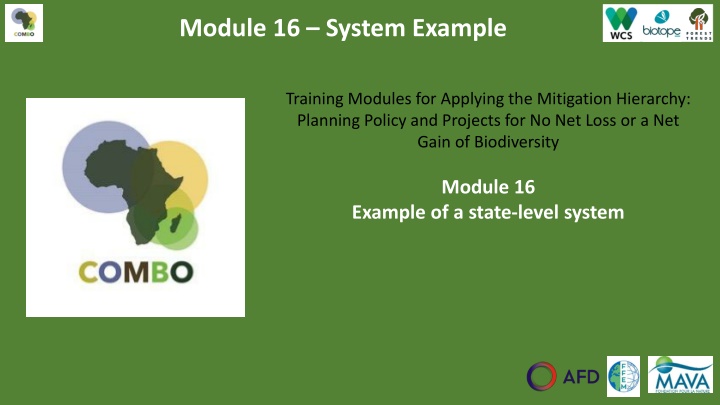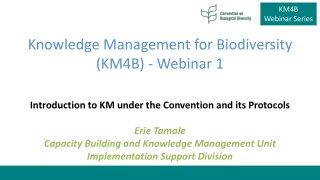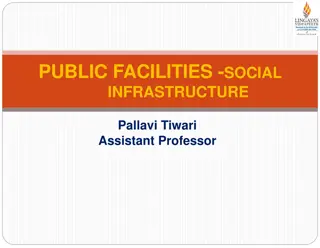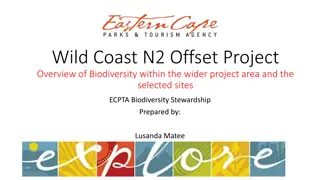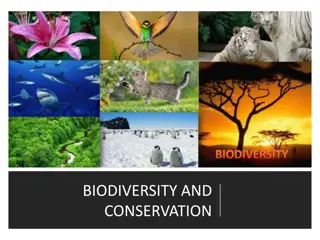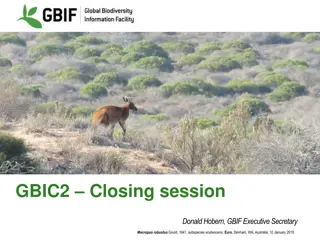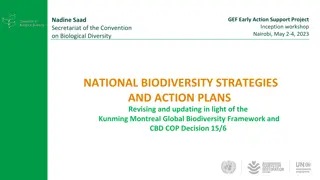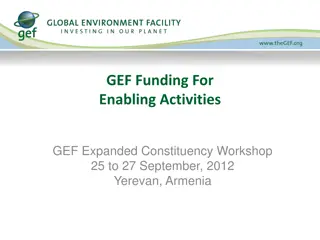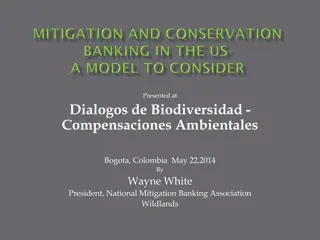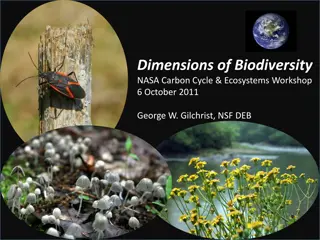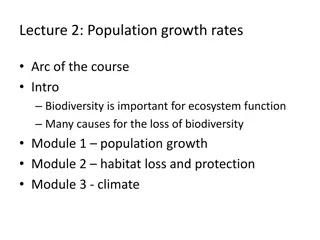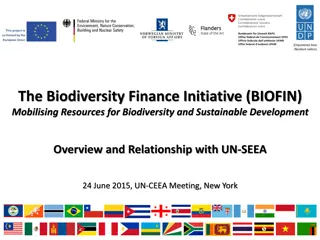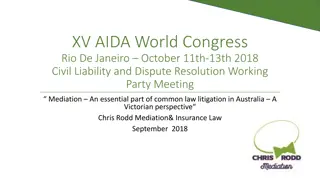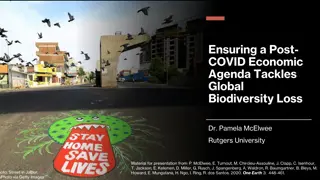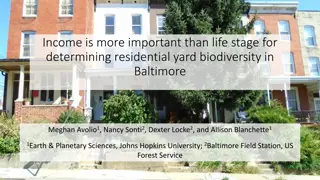Biodiversity Mitigation in Victoria, Australia: A Case Study
Exploring the biodiversity offsetting system in Victoria, Australia, this case study focuses on the state's efforts to achieve Biodiversity Net Gain. The modules cover topics such as ecological vegetation classes, habitat condition scores, offset implementation, and the evolution of offsetting practices in the region. With a look at historical biodiversity loss due to vegetation clearing, the example of Victoria showcases the importance of conservation efforts and mitigation strategies.
Download Presentation

Please find below an Image/Link to download the presentation.
The content on the website is provided AS IS for your information and personal use only. It may not be sold, licensed, or shared on other websites without obtaining consent from the author.If you encounter any issues during the download, it is possible that the publisher has removed the file from their server.
You are allowed to download the files provided on this website for personal or commercial use, subject to the condition that they are used lawfully. All files are the property of their respective owners.
The content on the website is provided AS IS for your information and personal use only. It may not be sold, licensed, or shared on other websites without obtaining consent from the author.
E N D
Presentation Transcript
Module 16 System Example Training Modules for Applying the Mitigation Hierarchy: Planning Policy and Projects for No Net Loss or a Net Gain of Biodiversity Module 16 Example of a state-level system 1
Module on Example of a National or State System Victoria, Australia Abstract Example: The system for mitigation in Victoria, Australia This Module aims to illustrate an earlier Module on planning to achieve Biodiversity Net Gain (or No Net Loss or similar goal) with the example of the State of Victoria in Australia. 2
Module on the example of Victoria, Australia Contents Slides Victoria and its biodiversity, including ecological vegetation classes 4-10 Biodiversity offsetting in Victoria: the Regulation, habitat condition scores, like for like and estimating loss and gain 11-25 Implementation of offsets the offset market credits, standards, registry 26-37 The Western Grassland reserve as an example of aggregated offsets 38-39 Evolution of offsetting in Victoria 40 Concluding remarks 41 3
Victoria Biodiversity offsetting in Victoria: an example With thanks to Michael Crowe 4
Offsetting in Victoria: outline 1. Victoria and its biodiversity 2. Biodiversity offsetting in Victoria 3. Implementation of offsets the offset market 4. Evolution of offsetting in Victoria 5
Native vegetation map of Victoria: Ecological Vegetation Classes 7
Victoria 8
Historical biodiversity loss Vegetation clearing has caused a major impact on biodiversity loss of habitat threatened species Clearing was highly selective two thirds is private land of which ~90% has been cleared Victoria 1750 Vegetation on private land is fragmented into patches and scattered trees Quality also degraded Victoria 2012 9
The Regulation Regulation of native vegetation clearing: Under the Planning and Environment Act A planning permit is required to clear native vegetation Assessment of permit applications based on the biodiversity significance of the impact Applications must demonstrate avoid and minimise steps The permit (if granted) requires an offset 11
Regulatory approach to impacts Impacts Exempt Small Medium Large Local government Exempt EIA Eg fire protection fence lines emergency works State government 12
Offset policy in Victoria The nature and size of the offset is set by the offset policy (statutory document): No Net Loss offsets are secure and ongoing quality/area metric - habitat hectares like for like rules for losses and offsets graduated requirements on biodiversity significance 13
High condition site benchmark attributes measured size & connectivity of the patch tree canopy cover large old trees understorey diversity recruitment of young trees logs & organic litter Habitat condition score= 9/10 14
Medium condition site benchmark attributes measured reduced cover of trees reduced recruitment reduced understorey diversity increased cover of weeds Habitat score= 5/10 15
Low condition site benchmark attributes measured greatly reduced vegetation in landscape only relict trees increased cover of weeds greatly reduced understorey diversity Habitat score= 2/10 16
Measuring quality - Habitat score Component Max. Value (%) Large Trees 10 Tree Canopy Cover 5 Understorey 25 Lack of Weeds 'Site 15 Assessed against a benchmark for each habitat type Regeneration (woody) Condition' 10 Organic Litter Component 5 Logs 5 'Landscape Patch Size 10 Neighbourhood Context' 10 Distance to Core Area Total Component 5 100 17
Biodiversity information Current extent of vegetation Type (Ecological Vegetation Classes) Benchmarks 1750 vegetation mapping Bioregions 28 Threatened species records 18
Biodiversity Significance Levels of biodiversity significance based on: Rarity of the vegetation type Quality of the vegetation Occurrence of threatened species Other attributes Ramsar wetlands, National Estate four levels of Significance Offset criteria are graduated according to biodiversity significance eg like for like 19
Offset criteria - Like for like Biodiversity significance Very High High Medium Low Vegetation or habitat type of offset The same vegetation/ habitat type in same bioregion Same vegetation/habit at type OR a VERY HIGH type in same bioregion Any type in the Bioregion OR a VERY HIGH or HIGH in same or adjacent Bioregion Any type in the Bioregion OR a VERY HIGH or HIGH in same or adjacent Bioregion Graduated response Trading Up 20
Loss and Gain For No Net Loss: Loss at the development site = Gain at the offset site where Loss at the development site = area x quality score (habitat hectares) and Gain at the offset site = area x quality score increment/ha 21
Types of Gain Three types of gain: Security gain where the offset is located: On private land with an on-title management agreement On public land with greater security (protected area) Surrender private land to public protected area Maintenance gain Forego entitled uses Control weeds Improvement gain Supplementary planting Reduce weed cover 22
Estimating Gain Total gain = area x quality increment per hectare Improvement gain Increments in quality attribute scores resulting from actions in the management plan Maintenance gain Increments in quality attribute scores resulting from actions in the management plan Security gain Increments in overall quality score depending on the change in land category 23
Example - Security Gain calculation Long-term chance of loss through clearing % 0 10 30 40 50 100 Class 1 Private land under covenant Protected area Class 2 Protected area Private land Security gain = current habitat score x increase in security (in Habitat hectares ) 24
Assessing loss and gain on site Site assessment: Site definition, habitat zones Habitat type Quality score Threatened species Biodiversity significance Loss score; or Management plan & gain score by accredited officer Relies on state-wide information! 25
Landowner agreement - Typical landholder actions Retain trees Control rabbits Exclude grazing Control weeds 26
Specification of the offset Developers Developers required to provide offsets, either by: first party; or third party Loss site assessment, Permit application Refer large impacts to State Government Local Government Determine small impacts Permit may be granted Permit includes offset conditions offset plan 27
Third party supply of offsets through a market Developers = BUYERS Credit Register Record of ownership Provides transparency & accountability to the market Provides market confidence that the credits meet the standards Single place where information about credits is recorded Ensures credits are only used once Brokers Conservation Banks Over the counter Create credits: Landowner agreements Land surrender Upgrade protected areas SELLERS Landowners Government = = 28
Development of system over time: Victoria 1989 - Regulation of native vegetation clearing an end to broad-scale clearing However offsetting was sporadic and unquantified 1998 - Biodiversity mapping extant vegetation, 1750 vegetation, bioregions, threatened species Provided state-wide information base 2000 - Auction-based incentive program BushTender introduced site assessment, landowner agreements Development of key techniques outside regulatory environment 2002 - Native Vegetation Management Framework no net loss, like-for-like, metrics However developers found it hard to find their offsets 2007/8 - Offset market based on credit trading third party suppliers, brokers, credit register Led to much better supply of offsets, but system too confused and too complex, problems on measurement 2013 - Reform of Native Vegetation permitted clearing regs clarified objectives, improved measurement of biodiversity, incorporated risk and proportionality, ensures appropriate compensation Think there s something 2016 to add 29
Market mechanism -Brokers Brokers find buyers and sellers for bespoke deals match using like-for-like rules facilitate price negotiation BushBroker the government-operated broker (2007) government start-up funding, now in cost recovery >300 trades, $34 million in value Private brokers Training and accreditation eg ESLink (2010), ~ 30 trades by 2018 .continuing 30
Offset market - credits Credits represent: A gain in the extent and or quality of native vegetation Credits are: The unit of trade in the offset market Measured in habitat hectares Also measured in Large Old Trees, number of plants Divisible Listed on the government operated Credit Register 31
Credit creation The landowner agreement: permanent statutory contract binds future landowners on title management actions specified in detail agency access to site reporting and monitoring progress payments Land surrender: private land donated to a Protected Area Upgrade Protected Area: government re-classify public land to higher security 32
Offset market - Standards for credits Quality Assurance Standards, training, accreditation: Site assessment - Vegetation Quality Assessment Manual Assessment by accredited field officers Gain calculated according to the Vegetation Gain Approach Site management and revegetation standards 33
Offset market - credit register Purpose of the Credit Register: BushBroker Record of ownership of credits Provides transparency and accountability to the credit market Provides the market with confidence that the credits meet the standards A single place where information about credits is recorded Credit Register Ensures credits are only used once Other brokers 34
Offset market - credit prices Bioregion Number of Agreements Total number of Habitat Hectares Average price per Habitat Hectare * (of total Agreements) Habitat Hectare price range * (more than 80% of Agreements) Central Victorian Uplands 8 10 $110,000 $46,000 - $143,000 Gippsland Plain 21 29 $149,000 $85,000 - $250,000 Goldfields 39 38 $45,000 $25,000 - $66,000 Victorian Riverina 10 11 $101,000 $80,000 - $110,000 Victorian Volcanic Plain $49,000 - $267,000 29 54 $170,000 Highlands- Southern Fall 14 74 $34,000 $20,000 - $38,000 $206,000 - $380,000 Other bioregions 11 25 $370,000 Prices vary by bioregion, EVC, location, rarity, demand and urgency of developer, landowner needs. Also initial trade, small or large trades 35
Market mechanism aggregated offset example Plains Grassland Plains Grassland - Victorian Volcanic Plain 36
Offset market mechanisms Risk to supplier increases Credit types Demand high and certain Demand low and uncertain Aggregated offsets & banks Bespoke trades through brokers Like-for-like rules (including trading up) determine market segmentation: Low segmentation banks and landscape solutions High segmentation bespoke and individual site solutions 37
Aggregated offset - Western Grassland Reserve A 15,000 ha reserve through the purchase and surrender of freehold land Will provide offsets for 15 years of urban development in Melbourne s west Designed via a Strategic Assessment Report of future impacts and offsets Land designated under an acquisition overlay Financed through a revolving fund, primed with government funding 38
Market mechanism Over The Counter Over The Counter: a bank of credits available at price pre-set by the landowner based on trading up to higher conservation significance offset specified in the permit condition offset plan provided at time of purchase walk in and buy - feels like in lieu payment 40
Concluding thoughts from Michael Crowe Michael Crowe prepared these slides based on his experience establishing and administering this system in Victoria. He recommends: Start simple and then build improvements over time Develop and test concepts in other areas e.g. use metrics in incentives program first Involve scientists in development of new information techniques Scale rigour and cost of offset transactions to significance and size of impacts Focus the purpose of offsetting on compensating for biodiversity losses Compliance for credit suppliers progress payments Offsetting needs to be regulated 41
